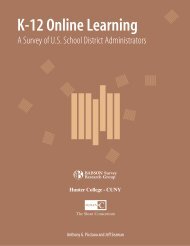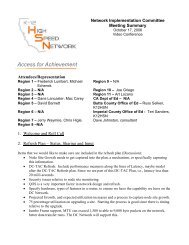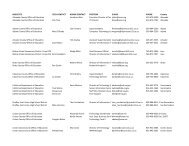Statewide Network Comparison: Overview - K12HSN
Statewide Network Comparison: Overview - K12HSN
Statewide Network Comparison: Overview - K12HSN
You also want an ePaper? Increase the reach of your titles
YUMPU automatically turns print PDFs into web optimized ePapers that Google loves.
APPENDIX A: Summary of High Speed <strong>Network</strong>s (Educational) by State<br />
Prepared by Jonathan Leavitt, MA<br />
Dept. of Educational Technology, San Diego State University<br />
State HSN initiative and link to site Size or impact on state<br />
(as described on program sites)<br />
=network.html<br />
Ring Type fiber optics network providing a 2.5<br />
Gbps backbone between Raleigh, Greensboro,<br />
Winston-Salem, and Charlotte.<br />
These services include access to national research networks, advanced video<br />
and distance learning services, and Internet access. NCREN is also the network<br />
backbone for the N.C. <strong>Statewide</strong> Grid – one of the nation’s first statewide grids<br />
for research and education which MCNC is building in partnership with the<br />
state’s public and private universities.<br />
Managed and owned by MCNC since 1985.<br />
MCNC is a non-profit entity that was founded in<br />
1980 by the NC General Assembly.<br />
Since 1987, the amount of Internet-based information on the statewide network<br />
has increased 25,000 fold, serving millions of research, education and<br />
government partners in North Carolina. The speed and capacity (bandwidth) of<br />
the network provide reliable service – today providing more than 5,000 times the<br />
speed of a cable modem and 90,000 times the speed of a typical dial-up Internet<br />
connection.<br />
Participants: more than 180 public and private institutions, including universities,<br />
community colleges, K-12 schools, libraries, state government, private research<br />
institutions and commercial businesses<br />
North Dakota<br />
<strong>Statewide</strong> Technology Access for Government<br />
and Education <strong>Network</strong> (STAGEnet)<br />
http://www.stagenet.nd.gov/<br />
STAGEnet was created by the 1999 legislative session. STAGEnet provides<br />
broadband connectivity, Internet access, video conferencing and other<br />
networking services. All state agencies, colleges and universities, local<br />
government, and K-12 are required to participate in STAGEnet.<br />
Participants: State agencies, colleges and universities, local government, and K-<br />
12 are required<br />
Ohio*****<br />
Ohio Academic Resources <strong>Network</strong> (OARNet)<br />
http://www.osc.edu/oarnet/<br />
Third Frontier <strong>Network</strong> (TFN)<br />
http://www.osc.edu/oarnet/tfn/<br />
Ring-type network that went online in 2004 and<br />
predicted to be fully functional by the summer<br />
of 2005. It will provide a fiber optics backbone<br />
which will deliver speeds of up to 2.5 Gbps.<br />
(OC-48) and hopes to offer educational<br />
research institutions connections of 9.9 Gbps<br />
over an OC-192 during 2005.<br />
OARNet is and ISP that provides the infrastructure for a variety of projects in<br />
Ohio. They are promoting the Third Frontier <strong>Network</strong> (TFN).<br />
TFN is a dedicated high-speed fiber-optic network linking Ohio colleges and<br />
universities with research facilities to promote research and economic<br />
development. Over 1,600 miles of fiber have been purchased to create the<br />
network backbone to connect colleges and universities, K-12 schools, and<br />
communities together.<br />
Participants: Colleges, universities, K-12 schools, and researchers



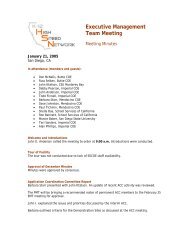
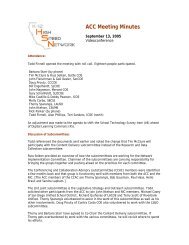

![Cyberbullying [K19, PRIV5] - Pew Internet & American Life Project](https://img.yumpu.com/23744339/1/190x245/cyberbullying-k19-priv5-pew-internet-american-life-project.jpg?quality=85)



